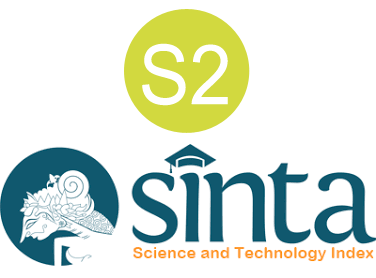Raja Marga Yoga Teachings as the Javanese View of Life in the Sêrat Bhagawad Gita
DOI:
https://doi.org/10.37329/jpah.v9i3.4120Keywords:
Javanese View of Life, Raja Marga Yoga, Sêrat Bhagawad GitaAbstract
The view of life is believed by a group of society as the guideline in living life to reach the true purpose of life. This study is aimed at explaining the view of the life of Javanese society following Raja Marga Yoga teachings as the path to reaching their God in Sêrat Bhagawad Gita. The data sources are text Piwulang Panunggal sarana Kawruh kang Luhur, tuwin Wêwados Kang Luhur in the manuscript of Sêrat Bhagawad Gita. It employed a qualitative research method to interpret the view of life in the texts. Data collection was conducted using reading-note techniques with the researcher as the main instrument. The validity of the data used was semantic validity and inter-intrarater reliability. Data analysis was conducted using qualitative model analysis. The result of this study revealed that Raja Yoga is the way to reach God by implementing the highest yoga technique, a secret knowledge. The harmony of the Javanese way of life of Raja Marga Yoga is as follows: 1) the greatness of dharma; 2) God is the source of all sentient beings; 3) praising the God: a) Mardikå sarånå Seleh Pandamêl, b) Mardikå sarånå Bêkti. By implementing Raja Marga Yoga, the human being will be able to achieve the true objectives of life which are being united with God.
References
Anggreni, N. M. (2017). The Concept and Value of the Teaching of Karma Yoga According to the Bhagavadgita Book. Vidyottama Sanatana: International Journal of Hindu Science and Religious Studies, 1(2), 146.
Anggreni, N. M. (2018). The Implementation Of Karma Yoga Teachings On Religious Life In Denpasar City. Vidyottama Sanatana: International Journal of Hindu Science and Religious Studies, 2(2), 261.
Darusuprapto. (1982). Serat Wulang Reh Anggitan Sri Paku Buwana IV. Surabaya: Citra Jaya.
Departemen Agama RI. (1994). Buku Pelajaran Agama Hindu untuk Perguruan Tinggi. Jakarta: Hanuman Sakti.
Dumadi, J. (2011). Mikul Dhuwur Mendhem Jero: Menyelami Falsafah dan Kosmologi Jawa. Yogyakarta: Pura Pustaka.
Flood, G. (2009). Hindu concepts. Retrieved from http://www.bbc.co.uk/religion/religions/hinduism/concepts/concepts_1.shtml#h2
Gautam, D., and Arora, N. (2019). Karma Yoga: The Pratical Way to Integrate Spirituality in Workplace. Journal of Advanced Research in Dynamical and Control Systems, 11(6 Special Issue), 1536–1540.
Hadiatmadja, S. (2011). Etika Jawa. Yogyakarta: Grafika Indah.
Hadiatmadja, S., and Endah, K. (2010). Filsafat Jawa. Yogyakarta: Kanwa Publisher.
Hamsah, U. (2003). Konsep Etika dalam Bhagavadgita. Filsafat, 13(3), 271–278.
Hartanto, D. D., and Nurhayati, E. (2017). Jñana Marga Yoga, Philosophy of Life in the Script of Sêrat Bhagawad Gita. Jurnal Penelitian Humaniora, 22(1), 1–18.
Hartanto, D. D., and Nurhayati, E. (2018a). Falsafah Hidup Bhakti Marga Yoga Dalam Naskah Sêrat Bhagawad Gita. Jurnal IKADBUDI, 6(1), 100–110.
Hartanto, D. D., and Nurhayati, E. (2018b). Pandangan Hidup Orang Jawa dalam Sĕrat Bhagawad Gita. Yogyakarta: Kanisius.
Hartanto, D. D., and Nurhayati, E. (2019). Falsafah hidup Karma Marga Yoga dalam naskah Sêrat Bhagawad Gita. LingTera, 6(2), 100–110.
Kadjeng et al, I. N. (1997). Sarasamuccaya. Denpasar: Paramita.
Lakshmi, D. S. (2013). Concept of Dharma in Shashi Tharoor‟s Show Business. 3L: The Southeast Asian Journal of English Languages Studies, 17(1), 93–101.
Made, Y. A. D. N. (2020). Karmaphala Tattwa dalam Matsya Purana. ŚRUTI: Jurnal Agama Hindu, 1(1), 68–80.
Maheswari, P. D. (2021). Formulasi Teologi Kerja dan Hubungannya dengan Reinkarnasi dalam Teks Bhagavad Gītā. Sphatika: Jurnal Teologi, 12(1), 112–127.
Miles, M. B., Huberman, A. M., and Saldaña, J. (2014). Qualitative Data Analysis (3rd ed.). Arizona: SAGE Publications, Inc.
Mulla, Z.R, and Krishnan, V. R. (2006). Karma Yoga: A Conceptualization and Validation of the Indian Philosophy of Work. Journal of Indian Psychology, 24(1/2), 26–43.
Mulla, Zubin R., and Krishnan, V. R. (2014). Karma-Yoga: The Indian Model of Moral Development. Journal of Business Ethics, 123(2), 339–351.
Parbasana, I. N. (2009). Panca Sradha sebagai Dasar Kepercayaan yang Universal. Denpasar: Widya Darma.
Partawiraya, R. M. (1929). Serat Bhagawad Gita. Kediri: Boekhandel Tan Khoen Swie.
Pudja, I. B. (2002). Buku Pelajaran Agama Hindu untuk Perguruan Tinggi. Yogyakarta: UNY Press.
Putro, R., Rohmadi, M., Rakhmawati, A., and Saddhono, K. (2019). Religion Caste Inside Sembah Catur on Serat Wedhatama, Pupuh Gambuh made by KGPAA Mangkunegara IV.
Saraswati, I. A. G. A., and Paramita, I. G. A. (2016). Konsep Surga, Neraka, dan Moksa dalam Kakawin Candra Bairawa. Dharmasmrti: Jurnal Ilmu Agama Dan Kebudayaan, 15(28), 29–44.
Simuh. (1988). Mistik Islam Kejawen Raden Ngabehi Ranggawarsita: Suatu Studi terhadap Serat Wirid Hidayat Jawi. Jakarta: UI Press.
Siswanto, J. (2003). Metafisika Wayang Dimensi Ontologis Wayang sebagai Simbol Kehidupan. Filsafat, 33(1), 73–85.
Siswanto, J. (2010). Metafisika Serat Jatimurti. Filsafat, 20(1), 1–25.
Suhardana, K. M. (2010). Catur Marga: Empat Jalan Menuju Brahman. Surabaya: Paramita.
Sujamto. (1992). Reorientasi dan Revitalisasi Pandangan Hidup Jawa. Semarang: Effhar dan Dahara Prize.
V. Reznik, S., V. Dekhnich, O., A. Kutomanov, S., A. Maidansky, M., and S. Filatova, Y. (2019). “Ahimsa” Principle in The Religious and Cultural Practices of Ancient and Contemporary India. Humanities & Social Sciences Reviews, 7(5), 830–834.
Vivekananda, S. (1920). Raja Yoga. New York: Brentano’s.
Wasim, A. T. (2006). Ajaran Hidup dalam Serat Warna-warni. In M. Tashadi (Ed.), Filsafat dan Ajaran Hidup dalam Khasanah Budaya Keraton Yogyakarta (pp. 94–110). Yogyakarta: YKII-UIN Sunan Kalijaga.
Wibawa, S. (2013). Filsafat Moral Jawa Seh Amograga dalam Serat Centhini Sumbangannya bagi Pendidikan Karakter. Yogyakarta: UNY Press.
Yogeshwar, G. (1994). Swami Vivekananda’s Concept of Jnana Yoga, Raja Yoga, Karma Yoga, and Bhakti Yoga. Ancient Science of Life, 13(3–4), 261–265.
Yumarma, A. (n.d.). Konsep Manusia dalam Gunungan: Sebuah Refleksi Filosofis terhadap Kearifan Lokal. 2012, 22(1), 18–30.
Zubair, A. C. (2006). Pandangan Hidup Jawa Yang Terdapat dalam Serat Jatipusaka Makutha Raja. In Mifedwil; Tashadi (Ed.), Filsafat dan Ajaran Hidup dalam Khasanah Budaya Keraton Yogyakarta (pp. 62–79). Yogyakarta: YKII-UIN Sunan Kalijaga.
Downloads
Published
How to Cite
Issue
Section
License
Copyright (c) 2025 Doni Dwi Hartanto, Endang Nurhayati

This work is licensed under a Creative Commons Attribution-ShareAlike 4.0 International License.
An author who publishes in the Jurnal Penelitian Agama Hindu agrees to the following terms:
- Author retains the copyright and grants the journal the right of first publication of the work simultaneously licensed under the Creative Commons Attribution-ShareAlike 4.0 License that allows others to share the work with an acknowledgement of the work's authorship and initial publication in this journal
- Author is able to enter into separate, additional contractual arrangements for the non-exclusive distribution of the journal's published version of the work (e.g., post it to an institutional repository or publish it in a book) with the acknowledgement of its initial publication in this journal.
- Author is permitted and encouraged to post his/her work online (e.g., in institutional repositories or on their website) prior to and during the submission process, as it can lead to productive exchanges, as well as earlier and greater citation of the published work (See The Effect of Open Access).
Read more about the Creative Commons Attribution-ShareAlike 4.0 Licence here: https://creativecommons.org/licenses/by-sa/4.0/.








